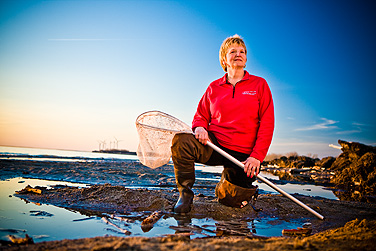Close Up
Great Lakes educator shares love of water with diverse audiences

Of all her constituents, Helen Domske says she especially enjoys working with anglers. Photo: DOUGLAS LEVERE
-
 Print
Print -
 Comments
Comments
-
“What’s better than to sit with your dad or your mom beside a beautiful body of water.”
Related links“Our Shared Waters” celebrates the centennial of the 1909 Boundary Waters Treaty
As an 8-year-old growing up in Buffalo, Helen Domske, Ed.M. ’85, knew she wanted to raise fish. This was no fleeting hobby with a solitary goldfish bowl, however. Before long, Domske had six fish tanks in the family’s living room, the smallest a 10-gallon tank; the largest held 100 gallons of water.
“My parents were saints, but they encouraged me to be entrepreneurial when my hobby became costly,” says Domske, associate director of UB’s Great Lakes Program and coastal education specialist with New York Sea Grant. “There was a local pet store where I could take in the fish I raised and they would trade for food. Unfortunately for me, my fish ate very expensive, frozen brine shrimp.”
Domske turned her childhood avocation into a lifelong commitment to water: A 30-year scuba diver in both marine and lake settings, she also loves to kayak on Lake Ontario not far from her Wilson home. Mostly, though, Domske has sought to educate others about the Great Lakes and other waterways.
After earning a B.S. in biology from SUNY College at Brockport, Domske went on to an Ed.M. in science education from UB. She was curator of education at the Aquarium of Niagara Falls before joining UB and New York Sea Grant in 1993. Named 2006 “Educator of the Year” by the Buffalo Museum of Science, Domske teaches and lectures on all things aquatic before children, anglers, college students and teachers. She’s also active in efforts to encourage scientists to make better use of the classroom in fostering scientific interest among the young.
Like others at UB, Domske focuses on the lower Great Lakes—Lake Erie and Lake Ontario. “The prime concern for people is the safety of the water. People should not be concerned about the quality of the drinking water we have from the lakes. The ecosystem itself is healthy, although there are still contaminants scientists are concerned about.”
A big issue nowadays, says Domske, is exotic, harmful species that have entered the Great Lakes primarily via ballast water from ocean-going ships. They include quagga mussels, which like the more familiar zebra mussels disturb the fragile ecosystem by filtering plankton, which supports all the biodiversity in the lakes.
While not yet in the Great Lakes, a possible future invader, the Asian “flying” carp, poses particular peril because of its large size (up to 100 lbs.) and outsize appetite. The carp are close to entering Lake Michigan through the Mississippi River basin; an electric barrier on the Chicago Sanitary and Ship Canal is intended to prevent this. “Depending on the type of carp, they can eat up to 50 percent of their body weight in plankton a day—that’s a lot of plankton being taken out of the water,” Domske says.
At UB, Domske is preparing for the June 12 “Connecting Channels” conference, whose sponsors include the Great Lakes Program, Canadian-American Studies Committee, Baldy Center for Law and Social Policy and Canadian Embassy. The conference is part of the centennial celebration of the 1909 Boundary Waters Treaty between the U.S. and Canada. In July, she’ll spend a week at Ohio State University’s Stone Lab on Gibraltar Island in Lake Erie, working with teachers from throughout the region. In August, she’ll take a dozen teachers to Roatan, Honduras, to learn about marine systems compared to the Great Lakes.
Of all her constituents, Domske says she especially enjoys working with anglers. “I never have to convince them about the importance of the lakes,” she says. “They know about the water temperature; they know about invasive species, because they’re seeing these water fleas, for instance, gum up their lines.
“The unfortunate thing is that a lot of young people aren’t filling those ranks—it really is a graying of the anglers. People should be taking their kids out to fish—there are such powerful environmental lessons and kids today just don’t interact with nature enough. Plus, what’s better than to sit with your dad or your mom beside a beautiful body of water?”

Reader Comments